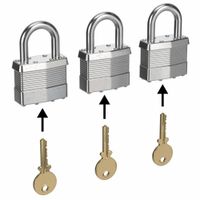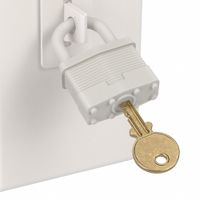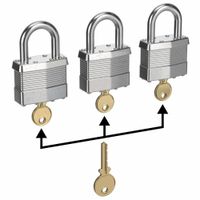Call +(254) 703 030 000 / 751 483 999 / 721 704 777
.....Read More
Frequently Asked Questions
What is the difference between keyed alike and keyed different padlocks?
Keyed alike and keyed different padlocks refer to the way the locks are configured in terms of key access.
Keyed Alike Padlocks:
- All padlocks in a keyed alike set can be opened with the same key. This means if you have multiple locks, you only need one key to open all of them.
- This configuration is convenient for situations where multiple locks need to be accessed frequently by the same person or group, such as in a business setting or for personal use where ease of access is prioritized.
- Keyed alike systems reduce the number of keys needed, simplifying key management and reducing the risk of losing keys.
- However, if one key is lost or stolen, all locks are compromised, which can be a security risk.
Keyed Different Padlocks:
- Each padlock in a keyed different set has its own unique key. No two locks can be opened with the same key.
- This setup is ideal for situations where security is a priority, and access needs to be restricted to specific individuals. Each person or group can have access to only the lock they are authorized to open.
- Keyed different systems enhance security by ensuring that a lost or stolen key does not compromise other locks.
- The downside is the potential complexity in managing multiple keys, which can be cumbersome and increase the risk of losing keys.
In summary, the choice between keyed alike and keyed different padlocks depends on the balance between convenience and security needs. Keyed alike offers ease of use, while keyed different provides enhanced security.
How do master keyed padlocks work?
Master keyed padlocks operate using a system that allows multiple keys to open one or more locks. This is achieved through a combination of standard pin tumblers and master wafers or pins.
In a typical pin tumbler lock, each pin stack consists of a driver pin and a key pin. The key pins are of varying lengths, corresponding to the cuts on a specific key. When the correct key is inserted, the key pins align with the shear line, allowing the plug to rotate and the lock to open.
In a master keyed system, additional master pins or wafers are inserted between the driver and key pins. These master pins create multiple shear lines within the pin stack. As a result, more than one key can align the pins to a shear line, allowing the plug to rotate.
For example, a lock might have a specific key that aligns the pins to one shear line, while a master key aligns them to another. This enables the master key to open multiple locks, each with its own unique key, by aligning the pins to the master shear line.
The master key system is hierarchical, often with several levels of keys. At the top is the grand master key, which can open all locks in the system. Below it, there might be master keys that open specific groups of locks, and below those, individual keys that open only one lock.
While convenient, master keyed systems can be less secure than single-key systems because the additional shear lines increase the potential for picking or unauthorized access. Proper management and restricted distribution of master keys are crucial to maintaining security.
What are the advantages of using keyed padlocks over combination padlocks?
Keyed padlocks offer several advantages over combination padlocks:
1. **Security**: Keyed padlocks generally provide higher security. They are less susceptible to being cracked by trial and error, as combination locks can be vulnerable to manipulation or guessing.
2. **Ease of Use**: Keyed padlocks are straightforward to operate. Users only need to insert and turn the key, whereas combination locks require remembering and accurately dialing a sequence of numbers.
3. **Durability**: Keyed padlocks often have more robust construction, making them more resistant to physical attacks such as cutting or prying.
4. **No Memory Requirement**: Users do not need to remember a combination, which can be forgotten or lost. This is particularly beneficial for those who may have difficulty remembering numbers or for infrequent use.
5. **Key Control**: With keyed padlocks, access can be controlled by distributing keys only to authorized individuals. Lost keys can be replaced, and locks can be rekeyed if security is compromised.
6. **Variety of Keying Options**: Keyed padlocks offer options such as master keying, where one key can open multiple locks, or keyed alike systems, where multiple locks can be opened with the same key, providing convenience in managing multiple locks.
7. **Weather Resistance**: Many keyed padlocks are designed to withstand harsh weather conditions, reducing the risk of malfunction due to rust or corrosion, which can affect the dials of combination locks.
8. **Tamper Evidence**: Keyed padlocks can show signs of tampering more clearly than combination locks, providing an indication of attempted unauthorized access.
Overall, keyed padlocks offer a reliable and secure option for protecting valuables, with the added benefits of ease of use and flexibility in key management.
Can keyed padlocks be rekeyed?
Yes, keyed padlocks can be rekeyed, but it depends on the design and brand of the padlock. Rekeying involves changing the internal mechanism of the lock so that it operates with a new key, rendering the old key useless. This process is common in pin tumbler locks, which are often used in padlocks.
Some padlocks are designed to be easily rekeyed by the user or a locksmith. These padlocks typically have a removable core or cylinder that can be replaced or adjusted to fit a new key. Brands like Master Lock and American Lock offer rekeyable padlocks, often with a specific rekeying kit or tool.
However, not all padlocks are rekeyable. Many inexpensive or older padlocks have a fixed cylinder that cannot be easily altered. In such cases, the entire lock would need to be replaced if a new key is required.
Rekeying a padlock can be a cost-effective solution for maintaining security without replacing the entire lock. It is particularly useful in situations where keys are lost, stolen, or when there is a change in personnel who have access to the lock.
For padlocks that can be rekeyed, it is often recommended to have the process done by a professional locksmith to ensure it is done correctly and securely. Some padlocks also allow for master keying, where multiple locks can be opened with a single master key, while each lock still has its own unique key.
In summary, while many keyed padlocks can be rekeyed, it is essential to check the specific model and brand to determine if rekeying is possible and practical.
How secure are keyed padlocks compared to other types of locks?
Keyed padlocks offer a basic level of security and are generally considered less secure compared to more advanced locking mechanisms. Their security largely depends on the quality of the lock and the materials used. High-quality padlocks with hardened steel shackles and complex keyways can provide reasonable protection against casual theft and tampering. However, they are vulnerable to several attack methods:
1. **Picking**: Many keyed padlocks can be picked using lock-picking tools, especially if they have simple pin tumbler mechanisms.
2. **Shimming**: Some padlocks can be opened by inserting a shim between the shackle and the body, exploiting gaps in the locking mechanism.
3. **Cutting**: Bolt cutters can easily cut through the shackles of lower-quality padlocks, though hardened steel shackles offer more resistance.
4. **Bumping**: Certain padlocks can be opened using a bump key, which is a specially crafted key that can manipulate the pins inside the lock.
5. **Drilling**: Drilling through the lock cylinder can disable the locking mechanism, though some padlocks have anti-drill features.
Compared to other locks, such as deadbolts or electronic locks, keyed padlocks are generally less secure. Deadbolts, especially those with high-security features, offer better resistance to forced entry. Electronic locks provide advanced security features like keyless entry, audit trails, and remote access, making them more secure but also more expensive.
In summary, while keyed padlocks can be suitable for low-risk applications, they are not the best choice for high-security needs. For enhanced security, consider using high-quality padlocks with advanced features or opting for more secure locking systems like deadbolts or electronic locks.
What is a coreless keyed padlock?
A coreless keyed padlock is a type of padlock that does not have a removable core or cylinder, which is typically found in traditional padlocks. Instead, the locking mechanism is integrated directly into the body of the padlock. This design can offer several advantages, such as increased security and durability, as there are fewer components that can be tampered with or damaged.
In a coreless keyed padlock, the key directly interacts with the locking mechanism, which is often more compact and less susceptible to picking or drilling. The absence of a removable core means that the padlock is generally more resistant to forced entry methods that target the core or cylinder. Additionally, the design can make the padlock more weather-resistant, as there are fewer seams or openings for moisture and debris to enter, reducing the risk of corrosion or mechanical failure.
These padlocks are often used in environments where high security is required, such as in industrial settings, storage facilities, or for securing valuable items. They can be made from various materials, including hardened steel or brass, to provide additional strength and resistance to cutting or sawing.
While coreless keyed padlocks offer enhanced security features, they may not be as versatile as padlocks with removable cores, which allow for rekeying or changing the lock mechanism without replacing the entire padlock. However, for applications where maximum security and durability are prioritized, coreless keyed padlocks are a reliable choice.
How do I choose the right keyed padlock for my needs?
To choose the right keyed padlock, consider the following factors:
1. **Security Level**: Determine the level of security you need. For high-security applications, choose a padlock with a hardened steel shackle, a double-locking mechanism, and a high-security cylinder. For low-risk areas, a standard padlock may suffice.
2. **Size and Shackle Clearance**: Ensure the padlock fits the hasp or chain you intend to secure. Measure the shackle diameter and clearance to ensure compatibility with your locking point.
3. **Material**: Select a padlock made from durable materials. Brass and stainless steel offer good corrosion resistance, while hardened steel provides enhanced cut resistance.
4. **Weather Resistance**: For outdoor use, choose a weather-resistant padlock with features like a covered keyway and rust-resistant materials to withstand harsh conditions.
5. **Key Control**: Consider the keying options. Keyed alike padlocks use the same key for multiple locks, ideal for convenience. Keyed different padlocks offer unique keys for each lock, enhancing security. Master key systems allow multiple locks to be opened with a single master key.
6. **Brand and Certification**: Opt for reputable brands known for quality and reliability. Look for padlocks with security certifications like UL, CEN, or Sold Secure, which indicate tested and verified security levels.
7. **Price**: Balance your budget with the required security level. Higher security padlocks tend to be more expensive but offer better protection.
8. **Additional Features**: Consider features like anti-pick pins, anti-drill plates, and rekeyable cylinders for added security and flexibility.
By evaluating these factors, you can select a keyed padlock that meets your specific security needs and environmental conditions.




